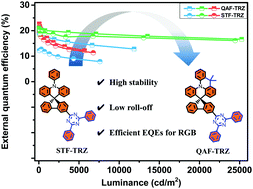Spiro-type host materials with rigidified skeletons for RGB phosphorescent OLEDs†
Abstract
A universal host material for red, green and blue phosphors raises challenges for the fabrication of efficient phosphorescent organic light-emitting diodes (PHOLEDs). Herein, two spiro host materials, namely 3-(4,6-diphenyl-1,3,5-triazin-2-yl)-9′,9′-dimethyl-9′H-spiro[fluorene-9,5′-quinolino[3,2,1-de]acridine] (QAF-TRZ) and 3′-(4,6-diphenyl-1,3,5-triazin-2-yl)-10-phenyl-10H-spiro[acridine-9,9′-fluorene] (STF-TRZ), are designed and synthesized. The designed strategy is more appropriate and rarely found among the reported spiro-based skeletons for organic light-emitting diodes (OLEDs). Both materials exhibited excellent electroluminescence performance. In particular, the RGB three-color PHOLEDs based on QAF-TRZ and STF-TRZ as hosts and FIrpic, Ir(ppy)2acac, and Ir(MDQ)2acac as emitters are fabricated. The blue PHOLEDs based on QAF-TRZ realize a maximum external quantum efficiency (EQE) of 19.4%, and remain 17.2% at 1000 cd m−2. On the other hand, green PHOLEDs show maximum EQEs of 21% and 19% for QAF-TRZ and STF-TRZ, respectively, and both devices exhibit low efficiency roll-off. The red devices obtain EQEs of 22.6% and 19.4% based on QAF-TRZ and STF-TRZ, respectively, in which the former has among the most efficient value. Consequently, these results confirm that host materials incorporating the spiro-motif with sufficiently high triplet energy are promising for obtaining high performance RGB-based PHOLEDs. The better device performance based on QAF-TRZ stems from its better hole transport capability, resulting in a superior charge recombination efficiency.

- This article is part of the themed collection: Editor’s Choice: Spiro compounds for electronics


 Please wait while we load your content...
Please wait while we load your content...